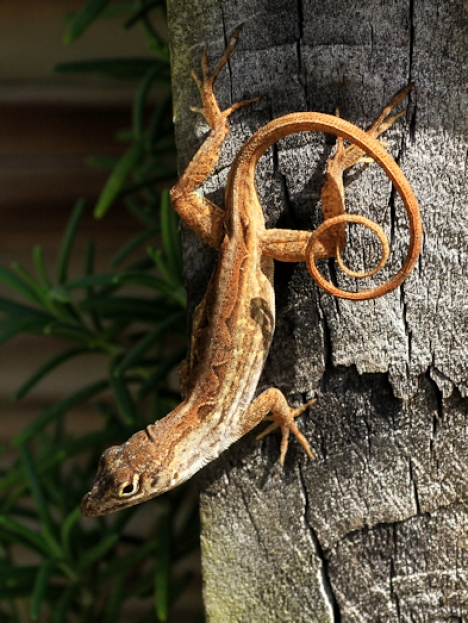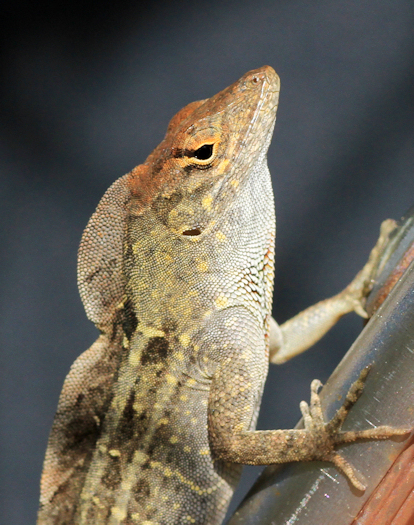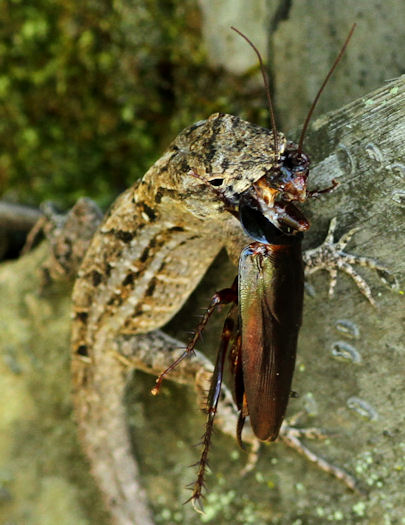It’s not clear whether Rick Shine would know an Anolis lizard if one hit him on the head, but there can be no doubt that he is a great scientist and herpetologist. Anole Annals is delighted to learn that tonight in Parliament House in Canberra, Australian Prime Minister Malcolm Turnbull will present Rick with the 2016 Prime Minister’s Prize for Science. Previous winners have been biomedical researchers, cell biologists and astronomers, among others. Read all about it here. Congratulations, Rick!
Author: Jonathan Losos Page 27 of 130
Professor of Biology and Director of the Living Earth Collaborative at Washington University in Saint Louis. I've spent my entire professional career studying anoles and have discovered that the more I learn about anoles, the more I realize I don't know.
Wendy Lee photographed a Graham’s anole eating another anole, probably an A. lineatopus. The event went down on November 25, 2013 in Runaway Bay, Jamaica, where Wendy runs a wildlife rescue facility, the Seven Oaks Sanctuary for Wildlife. We’ve discussed anoles eating other anoles several times in these pages, most recently with regard to A. sabanus.
Last week, Miguel Landestoy provided the details on the discovery of Anolis landestoyi, the new species from the Dominican Republic. The paper was published recently in The American Naturalist. Here’s what the press had to say:
The Canadian Broadcast Corporation:
A Caribbean lizard that remained undiscovered for many years despite its large size and distinctive looks has been identified as a new species.
The lizard, an anole that looks like a chameleon and has a similar talent for camouflage, lives in the canopy of a rare type of forest in the western Dominican Republic. Adults have a body length of up to 13.5 centimetres and a tail up to 18 centimetres long, making them unusually large for an anole. The new species is described as a “giant chameleon-like lizard” in a study published in the journal The American Naturalist.
The lizard was first spotted in 2007 by Dominican naturalist Miguel Landestoy while he was studying endangered birds called bay-breasted cuckoos.
‘There’s nothing else like that in and around the island.’– Luke Mahler, University of Toronto
“He noticed that these birds were agitated and seemed to be attacking something,” recalled Luke Mahler, a University of Toronto biologist and the lead author of the new study.
When Landestoy got closer, he saw a lizard and snapped a picture of it.
Convinced it was a new species, he showed the photo to Mahler, a lizard researcher who was working in the Dominican Republic at the time. But the photo was so grainy that Mahler couldn’t tell much other than it was an anole. He suggested that Landestoy try to capture a specimen.
Several years later, Landestoy spotted the lizard again and took some better photos.

Luke Mahler (left) and Miguel Landestoy (right) pose for a photo shortly after capturing the first specimens of Anolis landestoyi. (Luke Mahler)
“As soon as he sent the pictures,” Mahler recalled, “I was like, ‘What the expletive is that? … There’s nothing else like that in and around the island.”
He added that the Caribbean has been very well explored, so that typically, any new species found there are so similar to existing species that they can only be distinguished with DNA testing.
The new lizard was a big anole, with stubby limbs, a short tail, and green-grey and light brown scales that help it blend in among the moss-covered branches of the semi-dry tropical forest where it lives.
“It’s super camouflaged, basically. It looks just like the bark,” said Mahler, who thinks that’s why it’s never been spotted before. “It’ll sit there and hug a branch and very slowly move one limb at a time.”
The lizard is similar to related anoles found in Cuba called chamaeleolisor chamaeleonides because they’re also chameleon-like.
Different islands, similar adaptations
That’s intriguing because biologists have always expected to find a lizard similar to chamaeleonides on Hispaniola, the island shared by Haiti and the Dominican Republic. Islands in the Caribbean tend to have similar environments and tend to evolve species with similar adaptations, even if they are not closely related.

The newly discovered Hispaniolan lizard Anolis landestoyi (top) is very similar to the Cuban species A. porcus (bottom), part of a group called chamaeleonides. (Miguel Landestoy)
Mahler says more analysis needs to be done to figure out if the new lizard is similar to the chamaeleonides lizards because it’s closely related or because it evolved similar adaptations over time.
The new lizard has been named Anolis landestoyi after its discoverer.
Sadly, even though the new species was so recently discovered, it may not be around for much longer.
“We think that they’re probably quite endangered,” Mahler said.
That’s because it lives in a unique type of forest halfway up a mountain slope close to the border with Haiti. Although the forest is in a reserve called Lomo Charco Azul that’s officially protected, it’s threatened by illegal logging for agriculture, livestock grazing, and firewood.
The researchers are requesting that the new lizard be officially listed as critically endangered. They hope the new discovery will help draw attention to the threats to its habitat and lead to better protection.
We tend to think the contours of biodiversity are well known, especially in extensively studied areas. However, this is not necessarily the case and sometimes strikingly new species are discovered even in well-trod areas. A case in point is the country of the Dominican Republic, which has been thoroughly studied by biologists for more than 40 years, particularly by herpetologists who have exhaustively catalogued the reptiles and amphibians there for several decades.

AA is sorry to learn of the passing of Rodolfo Ruibal, an eminent Cuban herpetologist based at UC-Riverside for many years. Rodolfo did important early work on thermal biology andsocial behavior of Caribbean anoles. For example, 1961 paper showed thermoconformity in some lizards (when everyone though that lizards always thermoregulate carefully), it showed that physiology can evolve faster than morphology, and it proposed that only thermoregulators (not thermoconformers) could invade the temp zone.
You can find transcripts from a 1998 interview with Rodolfo as part of a UC-Riverside history project. Here’s the obituary that recently appeared in UCR Today:
Professor Emeritus Rodolfo “Rudy” Ruibal, a founding member of UC Riverside’s Biology department whose passions included lizards, frogs and making beautiful jewelry, died Aug. 30 at the age of 88, just six months after the death of his wife of 68 years, Irene Shamu Ruibal.
“He was instrumental in forging the department in the directions and expertise that form its center now,” said Professor Michael Allen, chair of UCR’s biology department.
Ruibal was a native of Cuba who conducted research in several parts of South America with fellowships from the National Science Foundation and the John Simon Guggenheim Memorial Foundation. He was an early student of temperature regulation in reptiles and amphibians, said friend and colleague Professor Mark Chappell, and was also known for his work with water loss in amphibians and their ability to waterproof their skin by using waxy glandular secretions the animals wipe over themselves.
“He taught the Biology 161 course, on functional vertebrate morphology, or ‘Vert’ to generations of premeds and other life science students, and was renowned for both the clarity of his lectures and for his skill in drawing structures on the blackboard,” said Chappell.
During Ruibal’s 42 years at UCR, he helped establish the Philip Boyd Desert Research Center and spent a year as the acting director of UC MEXUS, created to stimulate teaching and research between California and Mexico. Ruibal also spent a year advising a man he much admired—UC President Clark Kerr—about faculty requests and concerns.
“He always had one faculty member in his office,” Ruibal said during an oral history interview in 1998. “It was his way of simply making sure his faculty were being treated by an academic who knew what the score was, rather than somebody who was just a bureaucrat.”
Ruibal’s life read like a novel. He was born in Cuba on Oct. 27, 1927, an only child who attended the same Jesuit school as Fidel Castro. The budding scientist had an early fascination for animals, said his son, Claude Ruibal of Zurich, Switzerland. Rudy Ruibal’s earliest memories were of watching fish swimming in the waters of Cuba, and chasing lizards in his yard, something his aunt remembered years later, when he returned to Cuba for research on an NSF grant project.
Reptiles and research always fascinated Ruibal, and he excelled at an early age. He enrolled in Harvard when he was just 16 years old, after completing high school at the prestigious McBurney School in Manhattan.
Ruibal took a break from Harvard when he was 18, to serve in the military at the tail end of World War II. But he returned to school a year later and married his wife, Irene, a secretary in the Department of Herpetology in the American Museum of Natural History.
By the time he was 21, Ruibal had finished his BA at Harvard and enrolled at Columbia University for graduate studies in biology. At 26, Ruibal completed his PhD and accepted a position at a new liberal arts college called UC Riverside, where Howard Spieth, one of his former professors at Columbia, had become the chair of the life science’s department, and would later become the university’s first chancellor.
Ruibal began teaching in the fall of 1954, the second semester for a school so new that it had no landscaping or trees. Their son was born the following year, in 1955. Claude Ruibal said his parents were loving but not overbearing. His father, he said, “was a thoughtful guy, a moral guy—very rational and not very emotional. I don’t think I ever heard my parents argue.”
His mother loved to cook and throw dinner parties, and they cultivated a diverse group of close friends—artists, business people, even the publisher of the newspaper. His father loved tennis, playing into his 80s, and did a lot of reading about history and politics.
Ruibal also was a noted local artist. Shortly after he arrived in Riverside, he successfully lobbied the Riverside Art Museum to have real nude models available for sketching (instead of women in bathing suits). He later branched into candle making, ceramics —complete with his own kiln—and finally, making brass and silver jewelry, which were top sellers at the Riverside Art Museum, Mission Inn Museum and other locations.

Daffodil’s Photo Blog has some nice photos of stylish anoles. Some anoles–the festive anole (A. sagrei) being a prime example, seem to have a penchant for sitting with their tails hanging in a lovely. Why do they do it? Got me.
 We do know why they raise their dorsal crests–to look fearsome, as this mini-dinosaur does. How they do it, though, is another matter, when discussed previously in these pages (1,2).
We do know why they raise their dorsal crests–to look fearsome, as this mini-dinosaur does. How they do it, though, is another matter, when discussed previously in these pages (1,2).

There are many contenders, but my favorite is Anolis sericeus, seen above from the Kanahau research station on the Honduran island of Utila, and another photo below from Chiapas, Mexico.
The stuff of science fiction horror stories. We’ve previously reported on spiders eating anoles [e.g., 1, 2 and type “spiders” into search bar for more], but reports of anolivory by other invertebrates are scarce. Some others (from p.141 of Lizards in an Evolutionary Tree): katydids, tarantulas, whip scorpions, and centipedes.

Photo by Karen Cusick
It’s amazing the size of prey that some anoles will try to get down their throats (and who could blame them?). Here’s an example from Daffodil’s Photo Blog. And here’s another example from the same source.









